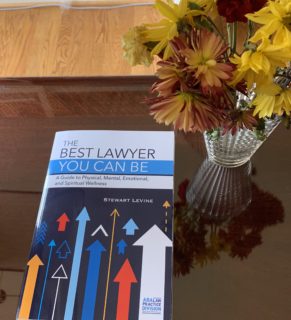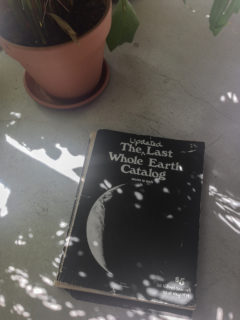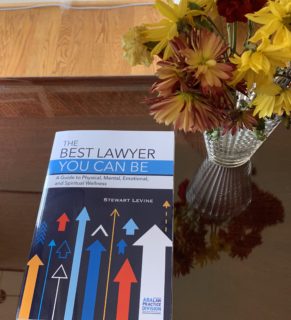The Best Lawyer You Can Be. A Guide to Physical, Mental, Emotional and Spiritual Wellness By Stewart Levine
 Stewart Levine’s new book reminds of the Whole Earth Catalogue written a number of years ago by another Stewart-Stewart Brand. For those too young to remember, the Whole Earth Catalogue was magazine and product catalog published several times a year between 1968 and 1972, and occasionally thereafter, until 1998. While it was directed mainly to a non mainstream, sort of countercultural audience, it did contain all sorts of product information, how to instructions and other valuable information. The goal of the Catalogue was to introduce those who were interested to some unique tools and information on topics not well addressed other places. Its theme was “access to tools” and that’s by and large what it delivered.
Stewart Levine’s new book reminds of the Whole Earth Catalogue written a number of years ago by another Stewart-Stewart Brand. For those too young to remember, the Whole Earth Catalogue was magazine and product catalog published several times a year between 1968 and 1972, and occasionally thereafter, until 1998. While it was directed mainly to a non mainstream, sort of countercultural audience, it did contain all sorts of product information, how to instructions and other valuable information. The goal of the Catalogue was to introduce those who were interested to some unique tools and information on topics not well addressed other places. Its theme was “access to tools” and that’s by and large what it delivered.
Stewart Levine’s new book. The Best Lawyer You Can Be similarly is a collection of various essays and short pieces from others, access to tools if you would, that will help us be better lawyers. Better not in the substantive senses-this is not a book about legal topics— like the rule against perpetuities, God forbid—but how we can be better from a physical, spiritual and emotional sense. Like the Whole Earth Catalogue, it is counter cultural in a sense, at least from a mainstream lawyers’ standpoint and attempts to introduce us to tools we can use but may not know about it.
So, for example, there are sections on mindful lawyering, collaboration, emotional intelligence, well being, finance, managing stress, even physical activity and nutrition, among others. There are number of essays in each section that are designed to introduce the reader to topics and whet their appetite for more. Many of the authors are well known in the field and each could probably write a book on their topic
The book doesn’t pretend to provide an in-depth, comprehensive of each component but is instead designed to introduce the various topics to us for further reflection and study. It’s an excellent starting place.
Lawyer wellness has been a topic that has received increasing attention of late particularly in light of the high levels of substance abuse, depression and even suicide among lawyers. It’s a topic that is a bit antithetical to the image of the hard charging, take no prisoners, Rambo lawyer that was popularized in the late 80s and continues to bedevil us even today. Stewart has taken the concept of wellness for lawyers and tried pretty successively to give us a nice sampling of all the various component of lawyer wellness in one place. The book doesn’t pretend to provide an in-depth, comprehensive analysis or discussion of each component but is instead designed to introduce the various topics to us for further reflection and study. It’s an excellent starting place.
Much of the information here I had read about before and I know many of the writers, including Stewart. So for me, there was not a lot new. But if you haven’t kept up to date with lawyer wellness or are just curious about what that means and includes, this book is a good introduction of many of the topics. And it can point you in the right direction if you want to know more.
While Stewart has done a good job grouping the topics, because this is a collection of article written by some 29 authors (if you count Stewart), it can be a little disjointed. Many of the articles are relatively short and of course the writing styles of the various authors differ which perhaps leads to a bit of disjointed nature. But given what Stewart was trying to do, it’s to be expected and is not horribly distracting.
 One criticism. You have to know Stewart: he is a likable, humble, self-effacing guy with perpetual good natured twinkle in his eye. The kind of guy who would give you the shirt his back if you asked for it. (More about Stewart is found below). He is not prone to seek the spotlight and prefers to help others more than himself. He has been in the lawyer wellness space a number of years and probably knows as much about it as anyone. Yet his writing in the book is pretty much limited to introducing the various topics and authors. Knowing Stewart, I know he has a lot to say and wish he had said more of it here. Perhaps he will give us that next time.
One criticism. You have to know Stewart: he is a likable, humble, self-effacing guy with perpetual good natured twinkle in his eye. The kind of guy who would give you the shirt his back if you asked for it. (More about Stewart is found below). He is not prone to seek the spotlight and prefers to help others more than himself. He has been in the lawyer wellness space a number of years and probably knows as much about it as anyone. Yet his writing in the book is pretty much limited to introducing the various topics and authors. Knowing Stewart, I know he has a lot to say and wish he had said more of it here. Perhaps he will give us that next time.
Like the Whole Earth Catalogue, this is a book you will probably refer back to and to some extent use a reference tool for yourself and others.
The book can be purchased from the American Bar Association at a cost of $39.95 for non-ABA and Law Practice Division members and $29.95 for Division members. Sadly, it is not available electronically. While a little pricy, like the Whole Earth Catalogue, this is a book you will probably refer back to and to some extent use a reference tool for yourself and others. So, in that regard, it’s not that expensive. And where else could you get the advice of 29 writers all in one place?
 The last edition of the Whole Earth Catalogue ended with a picture of a country road and the phrase “Stay hungry. Stay foolish”. My guess is that Stewart Brand and Stewart Levine are kindred spirits: Staying young and foolish in spirit might just be a good first step to lawyer wellness.
The last edition of the Whole Earth Catalogue ended with a picture of a country road and the phrase “Stay hungry. Stay foolish”. My guess is that Stewart Brand and Stewart Levine are kindred spirits: Staying young and foolish in spirit might just be a good first step to lawyer wellness.
About Stewart Levine
Stewart Levine is the founder of ResolutionWorks, a consulting and training organization dedicated to providing skills and ways of thinking needed to build strong organizational cultures. He spent ten years practicing law before becoming an award-winning marketing executive serving the legal profession at AT&T where he was recognized as a pioneer “intrapreneur.” He uses his approach to form teams and joint ventures in a variety of situations. Stewart has worked with large and small law firms, legal departments and government agencies across the country.
Stewart served on the Council of the American Bar Association Law Practice Management Section where he was Chair of the Education Board 2000-2003. He was a founding editorial member of the ABA Law Practice Management Ezine where he wrote a monthly column, “Management By Agreement” from 2003-2008. He was featured in an article about “Trend Setters” in the Legal Profession in Law Practice Magazine.
His book “Getting to Resolution: Turning Conflict into Collaboration” (Berrett-Koehler 1998) was called “a must read” by Law Practice Management Magazine. It was an Executive Book Club Selection; Featured by Executive Book Summaries; named one of the 30 Best Business Books of1998; endorsed by Dr. Stephen Covey, author of “Seven Habits of Highly Effective People” and featured in “The Futurist” magazine. It was a finalist for the 2009 Center for Public Resources book of the year. “The Book of Agreement” (Berrett-Koehler 2003) has been called more practical than the classic “Getting to Yes, ” and named among the best books of 2003 by CEO Refresher. www.Refresher.com. He co-authored “Collaboration 2.0” (HappyAbout 2008.) He is a frequent contributor to Legal Publications.
Stewart is an Honors graduate of Rutgers Law School where he was the Student Writing Editor of the Law Review. He served as a Deputy Attorney General for the State of New Jersey and was a Law and Humanities Fellow at Temple Law School where he was a law teacher.
In October 2010 Stewart was inducted into the College of Law Practice Management. www.COLPM.com. He served as an adjunct member of the faculty at the University of California Berkeley Law School.
Information: www.ResolutionWorks.com.
Photo Attribution

